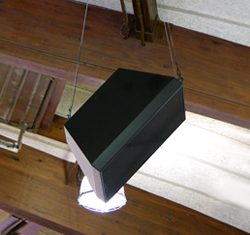Sound reinforcement systems are characterized by a wide variety of technical specifications. Although the term “throw” is not a technical specification, it’s frequently used to describe a specific performance parameter.
A frequent question is “how far will this loudspeaker ‘throw’?” Unfortunately, the answer requires additional information before it can be properly answered.
The “throw” question is asked in order to try and understand a loudspeaker’s ability to project some specific sound pressure level (SPL) over some distance. There are specific system performance parameters that must be considered, such as the loudspeaker’s 1 watt at 1 meter (1W/1m) sensitivity and power handling.
The 1W/1m specification can be a function of the loudspeaker’s directivity factor (or Q), and to that extent, the term “throw” and the Q are related but not identical (i.e., a customer’s request for a high Q/long-throw design.) Two loudspeaker systems, both with the same Q, will only have the same “throw” if the on-axis 1W/1m sensitivity and power handling are also identical. A loudspeaker system with a lower Q but higher 1W/1m sensitivity and higher power handling will actually “throw” farther then the “high Q” system!
Therefore, it’s important to make the distinction between “high Q” as it relates to a loudspeaker’s coverage angle and on-axis sensitivity.
On-axis sensitivity is a combination of the loudspeaker’s low-frequency (LF) device and high-frequency (HF) device (as well as a mid-frequency device when applicable), and the levels are matched to achieve smooth (or flat) frequency response.
The HF device (a compression driver feeding a horn) is usually the most efficient, and needs to be padded down to match the level of the LF device. If the HF device is high Q, it simply means that there is more pad required to achieve an acoustic match with the LF device. This can certainly be confusing, but the important concept here is that loudspeaker Q and coverage angles, although related, do not necessarily determine how far a loudspeaker will “throw.” Thus a “high Q” loudspeaker doesn’t necessarily translate to longer “{hrow.”
In addition to the performance parameters, the desired SPL at a specific distance is required to properly answer the question. So in reality, what is really being asked is “how loud will the loudspeaker be at a specific distance?”
















